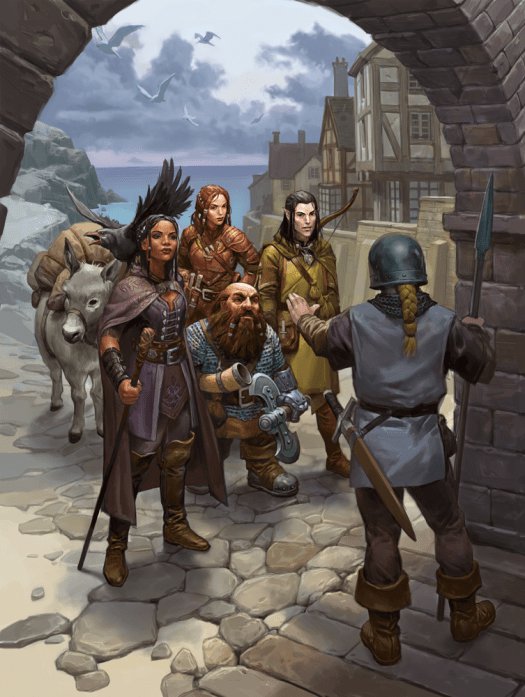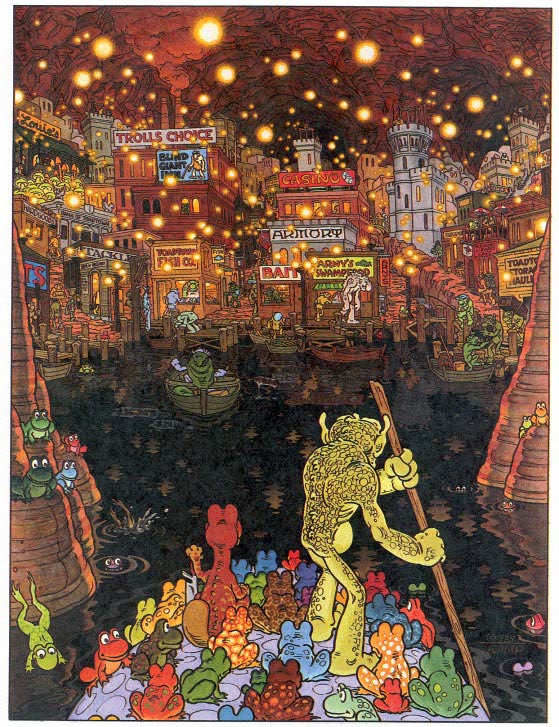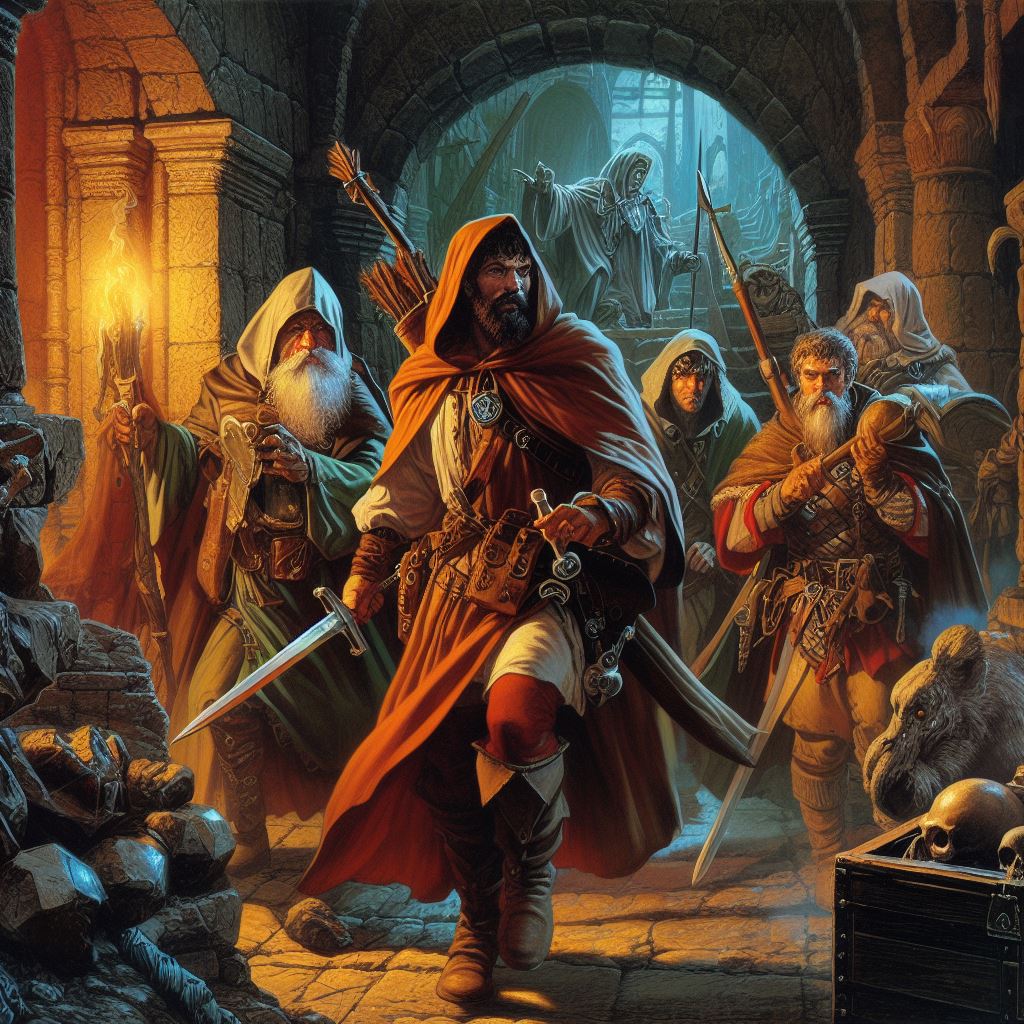Part I: Towns
by Joe Fischer


| - | - | Part 2: Wilderness | - | - |
| The Strategic Review | - | 1st Edition AD&D | - | Dragon magazine |
When talking to new D
& D judges, the one phrase most often heard from
them is: “Help!”

These players turned judges are usually
crammed full of ideas for new types
of traps, monsters, and treasure to spring
on their unsuspecting players, which is
great. The trouble, in most cases, seems
to be that they aren’t quite sure where to
start, which isn’t so great. Hepefully
this article will not only get you started, but
show you which way to go once you are
started.
When starting a new “castle,” there is
one necessity that every judge should
fulfill; that is giving the players a
base of operations where all equipment for outdoor
and dungeon expeditions can be bought,
and a place where player-characters
can stay in (comparative) safety between
adventures.
The best way to do this, besides just giving
the equipment to the players, is to
plan out a hamlet or town (or a small
city for those with ambition and graph paper
in plenty). In this way not only do the
players have a base to work from, but now
they can go on occasional “town adventures”
to break the monotony of dungeon
adventures, yet not risk their necks in
the wilderness.
If a town sounds like too much work, with
a little imagination, a judge can
come up with his own type of supply base.
In the now defunct castle “Black Star”
(one of my first attempts at castle building)
the first level was given over to inns,
pubs, and shops — including the shop of
a slightly crazy high level wizard who
seemed to have a little bit of everything,
including a chest of Gondorian Red, a
chest of Mordorian Black, and a balrog
butler named Boris (who “Black Star’s explayers
should remember well).
Should a judge decide on building a town,
he’ll have as many options as a new
Cadillac.
One of the first decisions to be made is
whether or not magical items are to be
sold in town. Actually most items shouldn’t
be sold but traded. (i.e. A magic-user,
having no use for a magic shield, could
trade it in for a scroll.) If so, remember that
the non-character selling them must be
powerful enough that the players can’t
acquire the magic by force. Also note
that a complete plan of the seller’s domicile
should be done. The magic should be sold
or traded at prices several times their
real value; the non-character is in business
to make money, not to help weak
characters.
Another feature of any town or city is
the local pub. Here player-characters,
at the cost of a round of drinks, can
find out latest happenings and more importantly,
local legends. Of course the judge should
decide first if he wants legends
in his game. If he does, then it is a
good idea to slip in an occasional “bummer”
legend, in with the rest. That way players
are a little more leery about following up
legends, and the bartenders don’t get
overworked.
It is a good idea to sketch out one or
two of the major bars simply because
literally hours of gaming time can be
killed by players “trying” to sit on a barstool
while picking up information and getting
drunk at the same time. (Remember, all
those mugs of ale add up.) And don’t forget
those barroom brawls. (But sire, I’m
innocent. If he hadn’t called you a son
of a pink dragon . . .)
Should the judge decide on a town for the
starting point of his game, he
should first map out the general area
surrounding his town and dungeon entrance(
s) on hexagon graphpaper, the scale depending
on the amount of detail the
judge desires. This way more than one
entrance to the dungeons can be made
available, and also player-characters
can, once they have the gold for it, pick an
area to build their castle homes.
The next part is, basically, setting down
some facts about the town.
Population, type (whether just a normal
town, walled city, port or a district
capitol, etc.) alignment of the government,
and so forth. At the same time, any
special town non-player characters should
be written down, along with any magic
or special items they might have. This
can be as simple or as complex as the judge
wishes. Naturally the more complex this
is, the more realistic and enjoyable town
adventures will be to the players.
Once this is all down on paper, the next
move is the mapping of the town itself.
This should be done with standard graph
paper: one square equals twenty
feet. (This can be modified for larger
towns.) And for ease of understanding, the
judge should develop some form of symbol
and color code should be used.
First map out the town’s walls, any bodies
of water, and any geographical
features that are outside the walls. This
should be done first in pencil, then in
color after the judge is satisfied with
his handiwork.
Next, any interior walls, such as the palace
walls, should be mapped out.
Make sure to make these different from
the main wall.

Then the town (if large enough to make
it necessary) can be broken down into
sections, (Thieves’ Quarter, Temple Precinct,
Peasants’ District, etc.) and each
section done one at a time. First, the
major buildings (temples, palaces, guild
halls, etc.) should be marked. Some of
these you might want to enlarge on a
separate map. Then, in order, major roads,
minor roads, minor stores, back alleys,
and lastly the homes of the lowly peasants
should be drawn in.